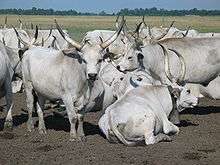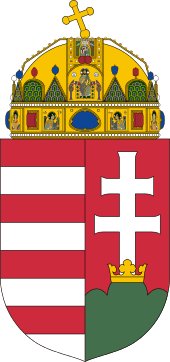List of World Heritage Sites in Hungary
The United Nations Educational, Scientific and Cultural Organization (UNESCO) World Heritage Sites are places of importance to cultural or natural heritage as described in the UNESCO World Heritage Convention, established in 1972.[1] Hungary accepted the convention on 15 July 1985, making its historical sites eligible for inclusion on the list.[2]
Sites in Hungary were first inscribed on the list at the 11th Session of the World Heritage Committee, held in Paris, France in 1987. At that session, two sites were added: "Budapest, the Banks of the Danube with the district of Buda Castle" and "Hollókő".[3] The names of these and other Hungarian sites were changed to their present names at the 27th session of the Committee in 2003.[4] Sites were added one at a time in the years 1995, 1996, 1999, 2000, 2001 and 2002. As of July 2014, Hungary has 8 total sites inscribed on the list. Of these two sites are shared with other countries: "Fertö / Neusiedlersee Cultural Landscape" with Austria; and the "Caves of Aggtelek Karst and Slovak Karst" with Slovakia. The latter is also the only natural site in Hungary.[2]
World Heritage Sites
UNESCO lists sites under ten criteria; each entry must meet at least one of the criteria. Criteria i through vi are cultural, whereas vii through x are natural.[5]
| Site | Image | Location | Year listed | UNESCO data | Description |
|---|---|---|---|---|---|
| Budapest, including the Banks of the Danube, the Buda Castle Quarter and Andrássy Avenue | .jpg) |
Budapest | 400; 1987;[nb 1] ii, iv | [6] | |
| Caves of Aggtelek Karst and Slovak Karst* |  |
Northern Hungary | 725; 1995;[nb 2] vii | [7][8] | |
| Early Christian Necropolis of Pécs (Sopianae) | Pécs | 853; 2000; iii, iv | 4th century Roman tombs richly decorated with Christian themed murals.[9] | ||
| Fertö / Neusiedlersee Cultural Landscape* |  |
Győr-Moson-Sopron County | 772; 2001; v | The Fertö/Neusiedler Lake area has been occupied by different peoples for eight millennia. A number of 18th and 19th century villages and castles were built on top of the ancient settlements and landscape.[10] | |
| Hortobágy National Park – the Puszta |  |
Borsod-Abaúj-Zemplén, Heves, Hajdú-Bihar and Jász-Nagykun-Szolnok Counties | 474; 1999; iv, v | [11] | |
| Millenary Benedictine Abbey of Pannonhalma and its Natural Environment |  |
Pannonhalma, Győr-Moson-Sopron County | 758; 1996; iv, vi | [12] | |
| Old Village of Hollókő and its Surroundings | _002.jpg) |
Nógrád County | 401; 1987; v | Palóc ethnographic village as a living example of life before the industrial revolution of the 20th century.[13] | |
| Tokaj Wine Region Historic Cultural Landscape |  |
Borsod-Abaúj-Zemplén County | 1063; 2002; iii, v | [14] |
Tentative list
In addition to sites inscribed on the World Heritage list, member states can maintain a list of tentative sites that they may consider for nomination. Nominations for the World Heritage list are only accepted if the site was previously listed on the tentative list.[15] As of 2014, Hungary recorded 11 sites on its tentative list. The sites, along with the year they were included on the tentative list are:[2]
- Le Château-fort médiéval d'Esztergom (1993)
- The Tihany Peninsula (1993)
- Caves of the Buda Thermal Karst System (1993)
- Mediaeval Royal Seat and Parkland at Visegrád (2000)
- System of Fortifications at the Confluence of the Rivers Danube and Váh in Komárno – Komárom (2007)
- The Network of Rural Heritage Buildings in Hungary (2000)
- State Stud-Farm Estate of Mezőhegyes (2000)
- The Wooden Churches of the Northern Part of the Carpathian Basin (2000)
- The Ipolytarnóc Fossils (2000)
- Ödön Lechner’s independent pre-modern architecture (2008)
- Frontiers of the Roman Empire – Ripa Pannonica in Hungary (2009)
- Royal Seats in Esztergom, Visegrád with the former Royal Wood in the Pilis Mountains (2017)
- Wooden Bells in the Upper Tisza-Region (2017)
- Balaton Uplands Cultural Landscapes (2017)
Notes
- Extended in 2003 to include Andrássy Avenue and the Millennium Underground and name change from Budapest, the Banks of the Danube and the Buda Castle Quarter to the present name.
- Extended in 2000 to include Dobšiná Ice Cave and modification of boundaries in 2008: increase of property at Esztramos Hill from 107.2 (265) to 195 (480) and establishment of a 28,000 (69,000) buffer zone on the Hungarian side.
See also
- Tourism in Hungary
- Lists of World Heritage Sites in Europe
References
- "The World Heritage Convention". UNESCO. Archived from the original on 23 May 2016. Retrieved 17 September 2010.
- "Hungary – Properties inscribed on the World Heritage List". UNESCO. Archived from the original on 14 July 2014. Retrieved 12 July 2014.
- "Report of the Rapporteur". UNESCO. 20 January 1988. Archived from the original on 31 July 2014. Retrieved 12 July 2014.
- "Committee Decisions 27 COM 8C.2 – Changes to Names of Existing Properties in Austria, Hungary and Slovakia". UNESCO. 10 December 2003. Archived from the original on 14 July 2014. Retrieved 12 July 2014.
- "UNESCO World Heritage Centre – The Criteria for Selection". UNESCO World Heritage Centre. Archived from the original on 12 June 2016. Retrieved 17 August 2018.
- "Budapest, including the Banks of the Danube, the Buda Castle Quarter and Andrássy Avenue". UNESCO. Archived from the original on 17 October 2011. Retrieved 20 October 2011.
- "Caves of Aggtelek Karst and Slovak Karst". UNESCO. Archived from the original on 6 October 2011. Retrieved 20 October 2011.
- "Decision – 32COM 8B.48 – Examination of nominations and minor modifications to the boundaries of naturel, mixed and cultural properties to the World Heritage List – Caves of Aggtelek Karst and Slovak Karst (HUNGARY / SLOVAKIA)". UNESCO. Archived from the original on 20 October 2011. Retrieved 20 October 2011.
- "Early Christian Necropolis of Pécs (Sopianae)". UNESCO. Archived from the original on 17 October 2011. Retrieved 20 October 2011.
- "Fertö / Neusiedlersee Cultural Landscape". UNESCO. Archived from the original on 10 November 2011. Retrieved 20 October 2011.
- "Hortobágy National Park – the Puszta". UNESCO. Archived from the original on 18 October 2011. Retrieved 20 October 2011.
- "Millenary Benedictine Abbey of Pannonhalma and its Natural Environment". UNESCO. Archived from the original on 17 October 2011. Retrieved 20 October 2011.
- "Old Village of Hollókő and its Surroundings". UNESCO. Archived from the original on 17 October 2011. Retrieved 20 October 2011.
- "Tokaj Wine Region Historic Cultural Landscape". UNESCO. Archived from the original on 17 October 2011. Retrieved 20 October 2011.
- "Tentative Lists". UNESCO. Archived from the original on 1 April 2016. Retrieved 12 July 2014.



